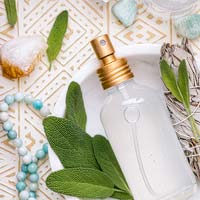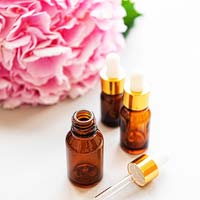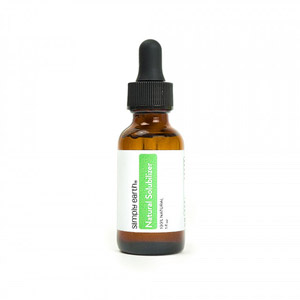Relax and rejuvenate your mind, body and soul with a Himalayan salt bath. With these easy to make pink salt bath recipes, you can unwind with a relaxing, aromatherapeutic and spa-like treatment right in the comfort of your own bathroom.
Read on to explore the benefits of bathing in pink Himalayan salt, including pink salts’ natural usefulness for energy cleansing. You’ll also find a selection of essential oil blends tailored to your desired salt soak experience.
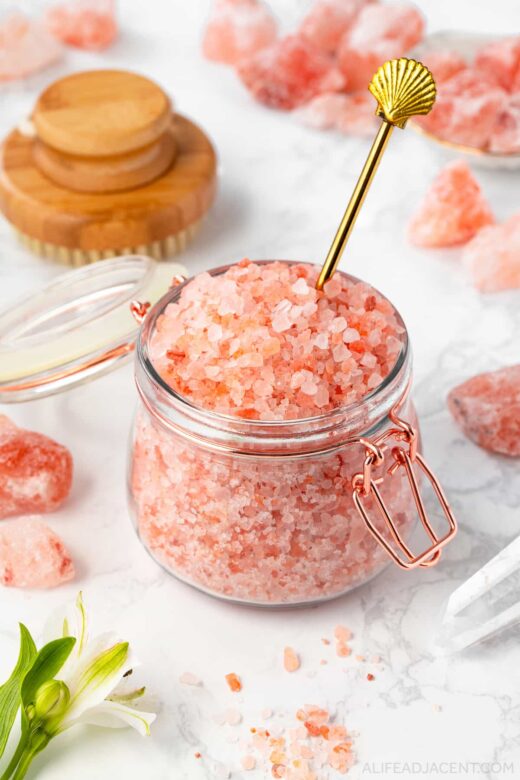
The healing, restorative power of salt baths has been recognized for centuries. Bathing in salt water is said to help relax the body, relieve itchy skin, ease headaches or migraines, boost circulation, reduce bloating, and clear negative energy.
But while a dip in the ocean or a trip to the spa is not always feasible, salt is inexpensive and always readily available. Chock full of natural minerals, a homemade pink Himalayan salt bath is a simple, inexpensive luxury to reap the benefits of bathing in salt at home.
Plus, a salt bath only takes a handful of natural ingredients and a few minutes to make – contrary to what the price tags of certain store bought pink salt soaks would have you believe.
In this article, we’ll cover even more reasons why a revitalizing Himalayan salt bath is a useful addition to your self-care and wellness routine. If you’re not a bath person, you can also use these recipes as a pink salt foot soak and still reap many of the benefits.
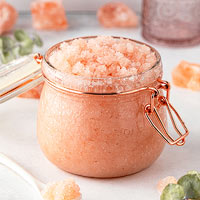

Pink Himalayan bath salts and their origin
Himalayan pink salt is a rock salt that hails from the Punjab province of Pakistan.
Contrary to the name, Himalayan salt doesn’t actually come directly from the foothills of the Himalayan mountains. In fact, the salt is hand-mined 186 miles away from the Himalayans, primarily from the Khewra Salt Mine in Pakistan, which is both a working mine and a tourist destination1.
Himalayan salts have a variety of uses and purposes. Aside from their use as bath salts, they’re a popular ingredient in both store-bought and homemade salt scrubs for their cleansing, detoxifying and skin-exfoliating properties.
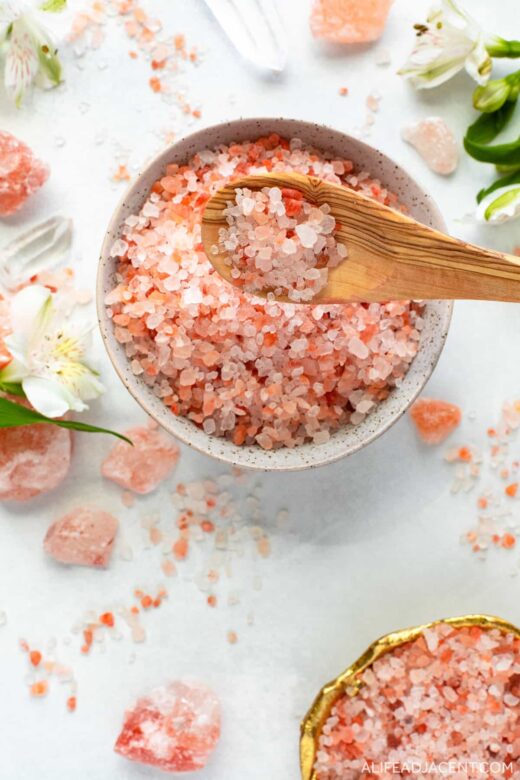
Himalayan salt is also often used as a common table salt. And salt lamps, of course, are currently very popular and found in many homes (we have 7!).
What makes Himalayan pink salt different from other bath salts?
One of the things that sets pink Himalayan salts apart from regular table salt, sea salt, or other bath salts is its beautiful rosy pink hue, which varies from soft pink to a deeper, reddish rust tone.
Pink salts also contain a number of trace minerals such as calcium, magnesium, zinc, chloride and potassium. Magnesium and iron oxides, in particular, are what gives pink salts their striking pink or reddish tone.
This is also what sets Himalayan salt apart from other bathing salts such as Epsom salt, which contains only magnesium sulfate, and Dead Sea Salt, which is comprised mainly of magnesium chloride and potassium chloride.
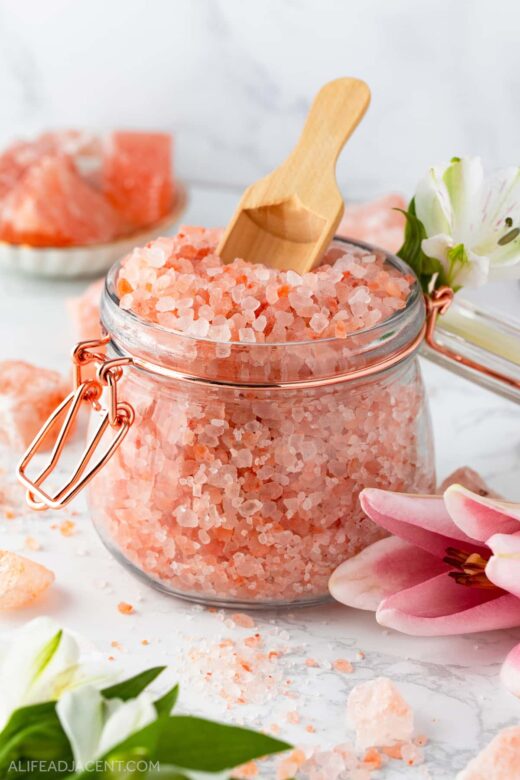
But aside from their color, taking a bath in pink Himalayan salts’ naturally occurring minerals may also provide benefits to your skin and body.
Himalayan Salt Bath Benefits
Alleviate muscle soreness and tension
As mentioned, pink salts contain minerals such as magnesium that can potentially be absorbed during bathing2, which is why a warm Himalayan salt bath may be used to alleviate sore or tired muscles, relieve tension, or ease menstrual cramps.
Taking a warm bath is a form of hydrotherapy that’s well know to aid pain relief3. Both magnesium and heat act as natural muscle relaxants that are potentially even more effective when combined.

Combat acne and deep cleanse the skin
Like all salts, Himalayan salts are highly antibacterial, antiseptic, and cleansing. Salt baths are known for their ability to help deep clean pores, dry out pimples, and draw out bacteria and impurities from the skin. This is turn can help combat acne and odor.
Bathing in pink salt can help reduce body acne by helping to reduce oil and acne-causing bacteria4. And since salt is also a natural cleanser and deodorizer, you might find a Himalayan salt bath (or scrub) helpful for combatting body odor after a long workout.
Soothe dry, itchy skin
Salt baths are also often used for treating a variety of skin concerns such as eczema, psoriasis5, and rashes, and pink salt’s naturally occurring minerals can help soothe inflammation and dry, itchy skin.
Salt has healing effects6, and bathing in mineral rich Himalayan salt may help calm irritation, redness or swelling from bug bites, eczema or other minor inflammatory skin conditions.
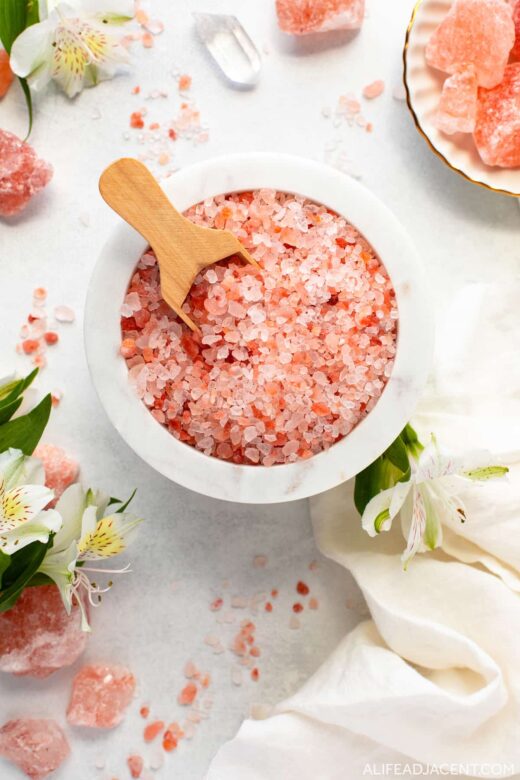
In one study, bathing in magnesium-rich salts improved skin barrier function, enhanced skin hydration, and reduced inflammation in atopic dry skin7.
However, it’s important to consult with your health care provider before using any DIY salt bath recipe to treat skin issues. Many find salt baths helpful, but in certain cases, they can also worsen symptoms.
Promote relaxation
Since soaking in warm water relaxes the mind and body, a Himalayan salt bath can be a lovely way to pamper yourself at the end of a long or stressful day.
Immersing in warm, salty bath water promotes a feeling of calmness, well-being, and rejuvenation8. A warm pink Himalayan salt bath may also help you fall asleep faster, especially if you also add a calming essential oil blend with lavender oil to your bath water.
Reduce or ease headaches or migraines
The warmth of a pink salt bath may also help to lessen headache pain, including tension headaches and migraines9.
While it doesn’t cure a headache, a very warm salt bath followed by a cool rinse can provide some relief from the pain. As someone who experiences chronic migraines, I find alternating hot and cold water helpful during a headache.
But as always, consult your health practitioner to determine if this method is safe for you.
Boost circulation for glowing skin
A warm bath in Himalayan bath salts improves blood flow and boosts circulation, which helps leave your skin looking healthier, radiant, and more glowing.
But it doesn’t just give your skin a surface level glow – blood flow delivers vital nutrients to the skin, helping to nourish your skin from the inside out. So if your skin looks dull or lacklustre, a Himalayan salt bath may help boost your radiance.
Energy cleansing and spiritual benefits
If you have a spiritual practice, you likely already believe that everything is energy, and that you can pick up negative energy from the environment and the people around you during daily interactions. You may be more likely to sense this if you are empathetic or energetically sensitive.
Energy cleansing and clearing practices and beliefs originated from Native American culture, African culture and Hinduism, to name a few. In these cultures as well as in spiritual communities, salt is often used as a natural energy cleanser to help clear discordant and negative energy from your auric field.

If you’re feeling off energetically, you can use a Himalayan salt bath for energetic self care.
To use a pink salt bath ritual to cleanse your energy, be sure to create a peaceful atmosphere in your bathroom before drawing your bath, whether that’s with beautiful crystals, salt rocks, relaxing music, spritzing an aura spray, or burning sacred incense or herbs.
At-home halotherapy
Pink salt baths can be used as an at-home method of wet salt therapy or halotherapy.
Halotherapy is a treatment that involves the breathing of salt crystals, which has been confirmed by clinical trials to help alleviate the uncomfortable symptoms of certain respiratory conditions10, such colds, sinus infections, rhinitis, or seasonal allergies.
If you’re feeling stuffy, taking a Himalayan salt bath may help alleviate sinus congestion. However, halotherapy is not intended to cure any disease, so you should always consult your health professional before using home remedies such as salt baths to manage your symptoms.
De-bloating and detoxifying
If you’re feeling bloated or retaining water, soaking in pink Himalayan salt may potentially help relieve some discomfort and distension.
Keep in mind that there’s little scientific evidence to support a salt bath’s de-bloating benefits. However, there are many anecdotal reports that bathing in warm salt water help can help relieve bloating caused by water retention, digestive distress, or menstrual cycles.
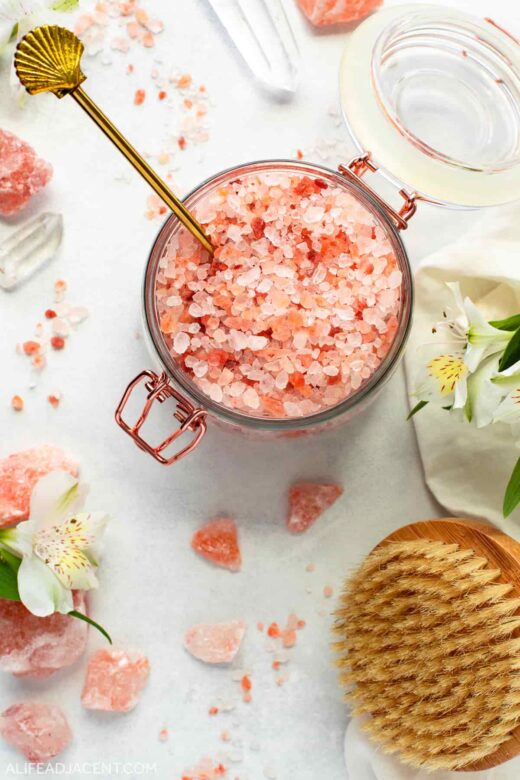
Salt draws out moisture, so it may work by helping to pull excess fluid out of the body’s tissues. This is also the same idea behind a salt bath’s purported detoxifying properties, as bathing in salt is said to help pull impurities from the skin.
Plus, warm bath water helps you sweat, which may help eliminate toxins similar to a sauna session. You can also bolster these effects by adding warming essential oils such as ginger root and star anise to your Himalayan bath salts, which can also help soothe digestive discomfort.
Aromatherapy benefits
A homemade salt bath with essential oils is an easy way to enjoy the benefits of aromatherapy. The addition of soothing aromatherapeutic essential oils are a treat for your senses and help calm your mind and body.
Soaking in a warm Himalayan salt bath surrounded by essential oils’ natural aroma can soothe frazzled nerves, reduce feelings of anxiety, stress or overwhelm, as well as uplift your mood.
Some essential oil blends can also help reduce headache pain, alleviate muscle aches and tension, and help even support your fitness and wellness routine. You can find several pink salt bath essential oil blends for all of the above below.
Himalayan bath salts ingredients
To make a pink salt bath, you’ll need high-quality pink Himalayan salts, essential oils for natural fragrance and aromatherapy, and a natural emulsifier to disperse the oils in your bathwater.
However, a natural emulsifier is only necessary if you add essential oils to your bath. If you’d prefer a simple, unscented pink salt bath, you can skip this ingredient.
I kept it intentionally simple for these salt bath recipes, but if desired, you can also add optional ingredients such as moisturizing milk powder or dried flowers.
Milk powder can help counteract any of the pink salts’ skin-drying effects, while botanicals such as pink rose petals add a touch of beauty and luxury. If you’re vegan or avoiding dairy, you can also use coconut milk powder.
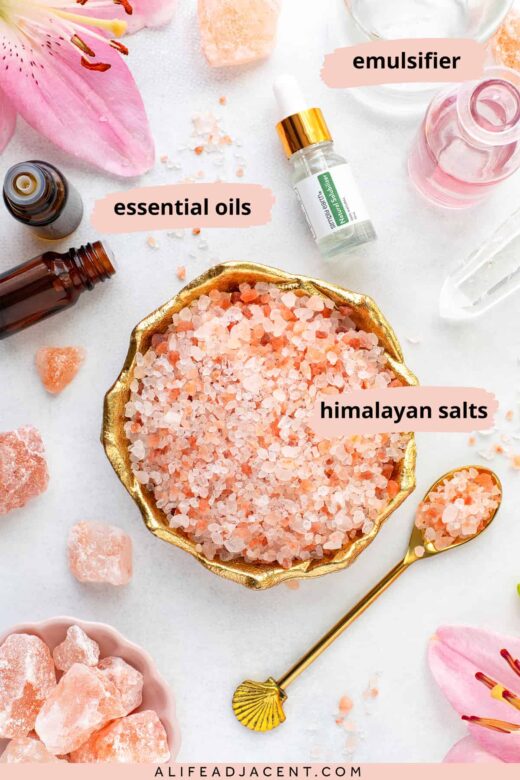
Pink Himalayan salts
Gorgeous pink Himalayan salts are of course the main ingredient in a Himalayan bath soak.
What kind of Himalayan salts should you use in a salt bath? You will want to use a high-quality pink salt free of any artificial additives or colors to make this salt bath recipe. Be sure to check the ingredients label and ensure you’re using only 100% pure Himalayan pink salt.
You can choose to use coarse salt crystals, medium coarse granules, or fine pink salt for bathing – it’s entirely up to personal preference.
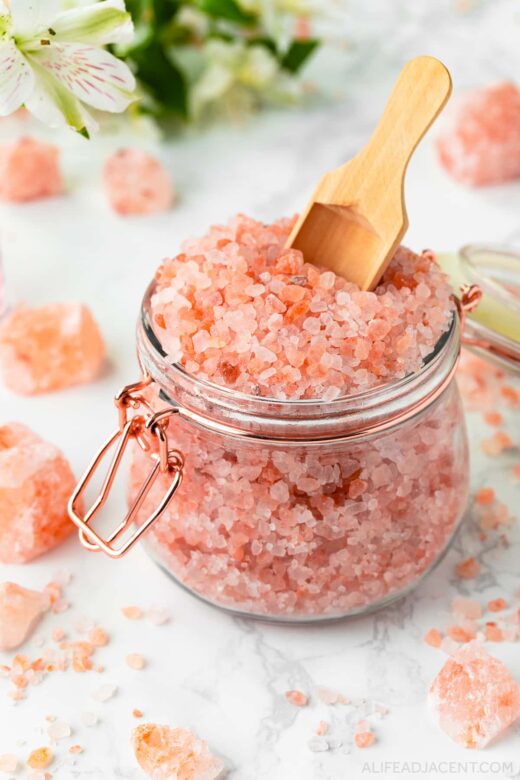
You can even buy extra large chunks of Himalayan salt crystals such as the ones pictured in this article, and place them directly into the bath. But please note that rock salt chunks will take longer to dissolve in your bath water, and extra caution should be taken to avoid injury.
You can also mix a variety of bath salts to reap their combined benefits, such as this bath salt blend of pink salt, Epsom salt, and Dead Sea salt that we recommend.
Natural bath salt emulsifier
Using a small amount of a natural essential oil solubilizer or liquid emulsifier is important when using essential oils in the bath.
Essential oils and water don’t mix, so without an emulsifier, the oils pool on the surface of your bath water. This can potentially cause skin rashes or even minor burns when the undiluted essential oils contact your skin.
That’s why I included caprylyl/capryl glucoside in these Himalayan bath salts. It’s an inexpensive, naturally derived solubilizer that evenly disperses essential oils into bathwater. Plus, you can also use in it many other bath soak recipes such as our green tea bath or milk and honey bath soak.
Caprylyl/capryl glucoside is available from Simply Earth and most bath and body ingredients suppliers. Other natural emulsifiers that can be used in salt bath recipes include: CreamMaker FLUID, polyglyceryl oleate, sorbitan oleate, and Natrasorb Bath starch.
Can you use polysorbate 80 as an emulsifier in pink bath salts?
I don’t recommend using polysorbates in a salt bath recipe. Polysorbate 80 or Polysorbate 60 are commonly used emulsifiers for bath salts and bath bombs. However, these ingredients undergo chemical ethoxylation, which can leave behind toxic residue.
If you strive to live a more natural lifestyle, in the same way you wouldn’t make a food recipe with unhealthy or processed ingredients, you likely want to choose more natural ingredients for your bath and body recipes as well. Especially if you’re making a homemade Himalayan salt bath for the purpose of supporting your wellness.
Essential oils
Adding essential oils to your salt bath is entirely optional. If you have highly sensitive skin or are sensitive to essential oils, you can omit the oils and still reap the benefits of soaking in a pink salt bath.
But for aromatherapeutic benefits, you may want to make these Himayalan bath salts with essential oils, such as lavender oil for calming, or ginger oil for muscle soreness.
After the recipe below, you will find a section on essential oil blends that compliment a salt bath depending on your needs and desired bath experience, including blends for pain relief, relaxation, energy cleansing, and more.
Pink Himalayan Salt Bath Recipe
4 cups pink Himalayan salts (options include coarse crystals, medium grind, or bath salt blend)
1 tsp / 5ml caprylyl/capryl glucoside solubilizer
40 drops essential oils (see blends below)
Optional ingredients
1/4 cup whole milk powder (optional)
1/4 cup dried botanicals such as rose petals, lavender buds, amaranth, or jasmine flowers (optional)
Supplies needed to make pink bath salts
Large glass mixing bowl
Wooden spoon for mixing
Small glass beaker for measuring and mixing emulsifier and essential oils
Small spatula to mix oil blend
Storage containers such as glass bath salt tubes, small mason jars with clamp lids, or glass bath salts jars with attached wooden bath scoops
🥣 How to make Himalayan bath salts with essential oils
- To make a Himalayan salt bath, start by placing the pink salts into a large glass mixing bowl.
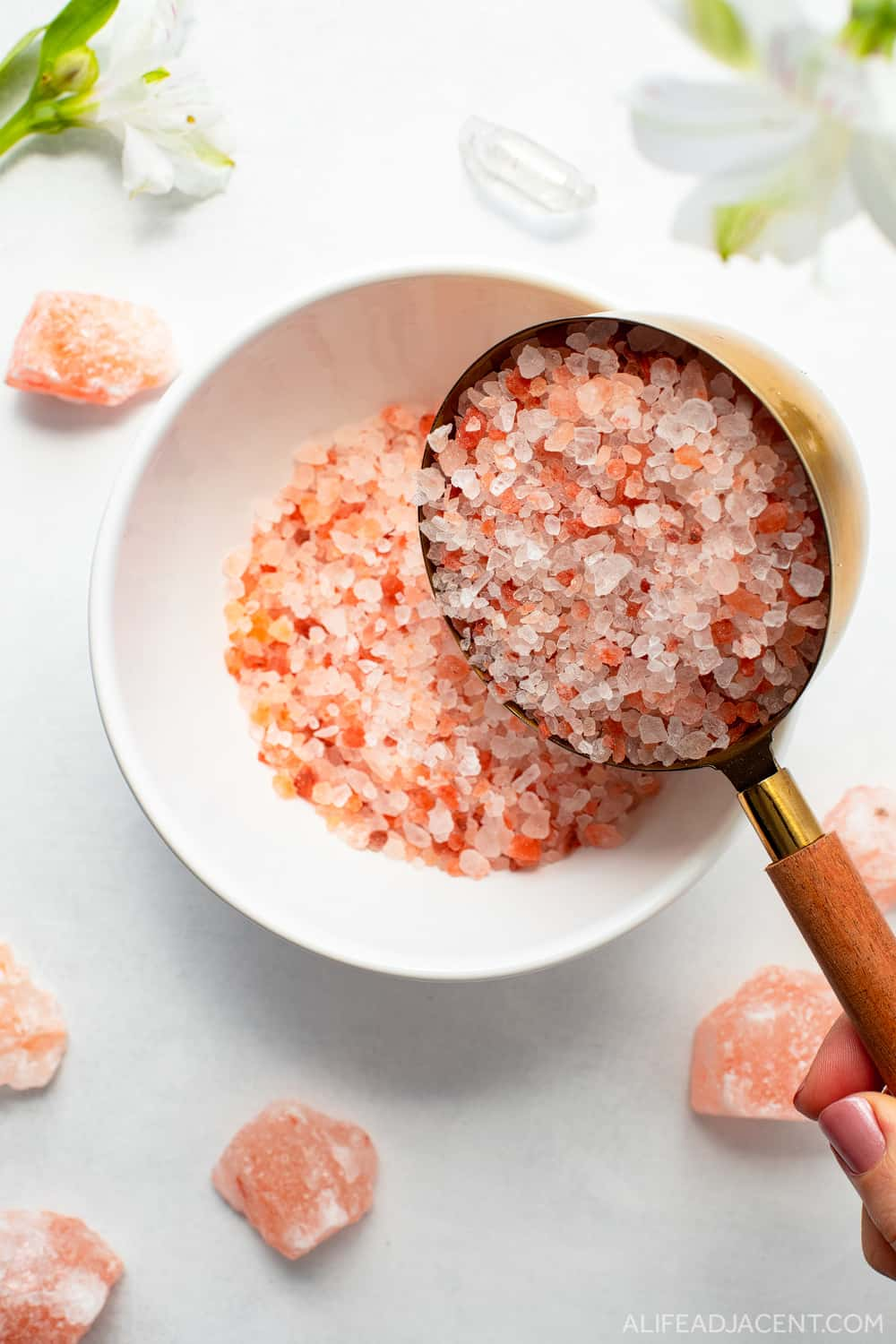
- Measure the natural emulsifier into a separate small container or glass beaker. Then, add your favorite essential oils – see the bath salt essential oil blends section below.
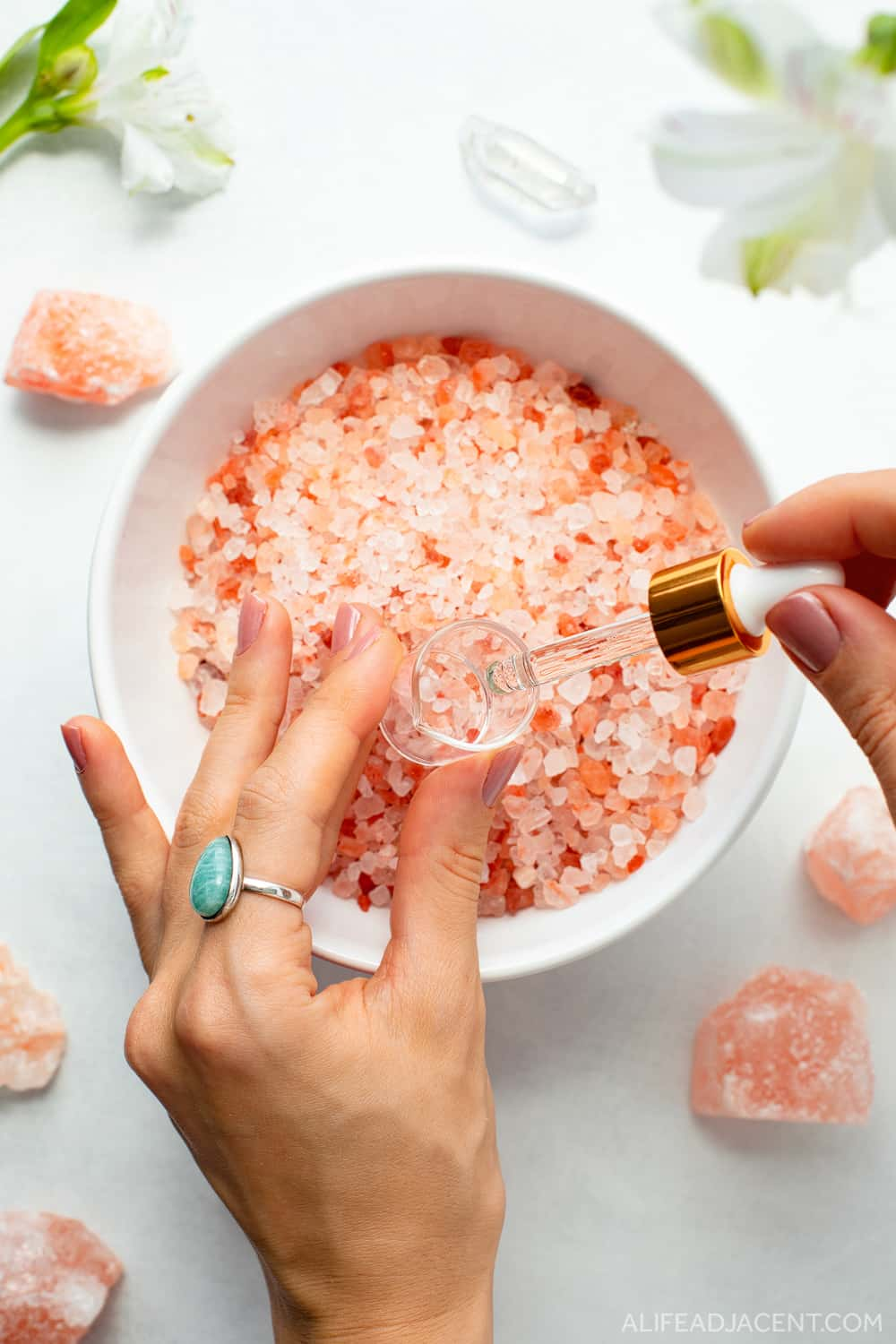
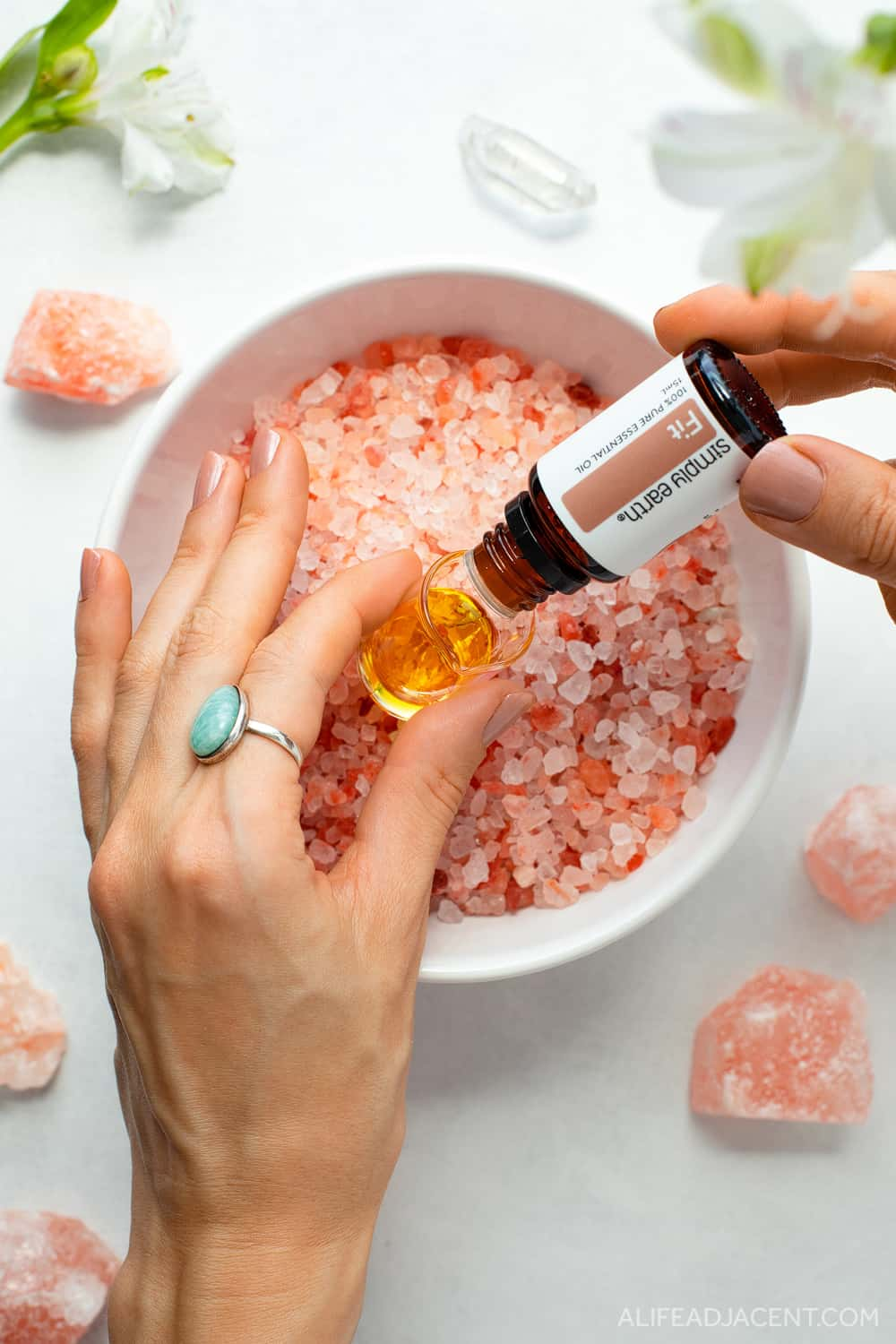
- Mix well with a small spoon or spatula to fully solubilize the essential oils in the emulsifier. Then, slowly drizzle this mixture over the bath salts, using a wooden spoon to mix as you go.
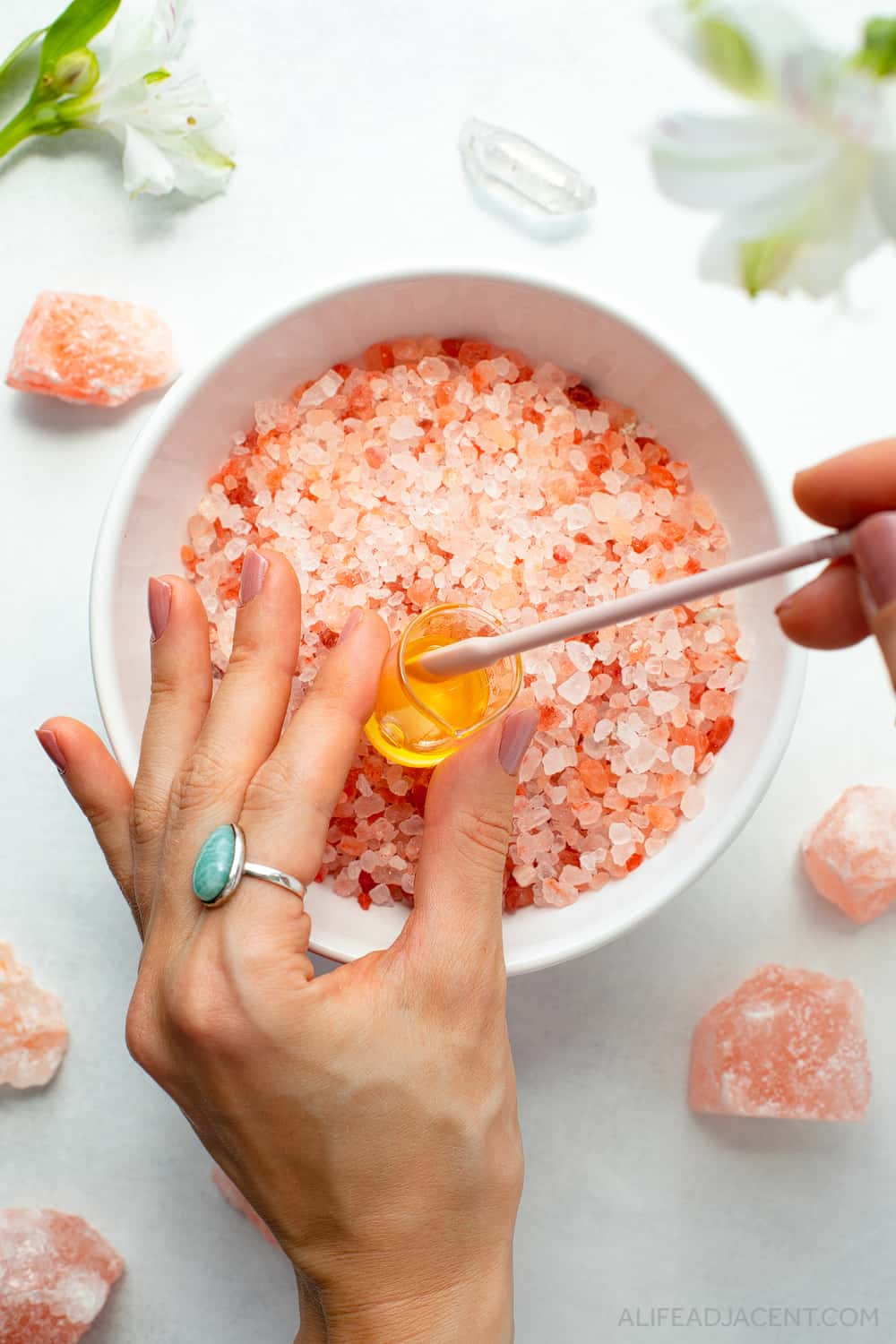
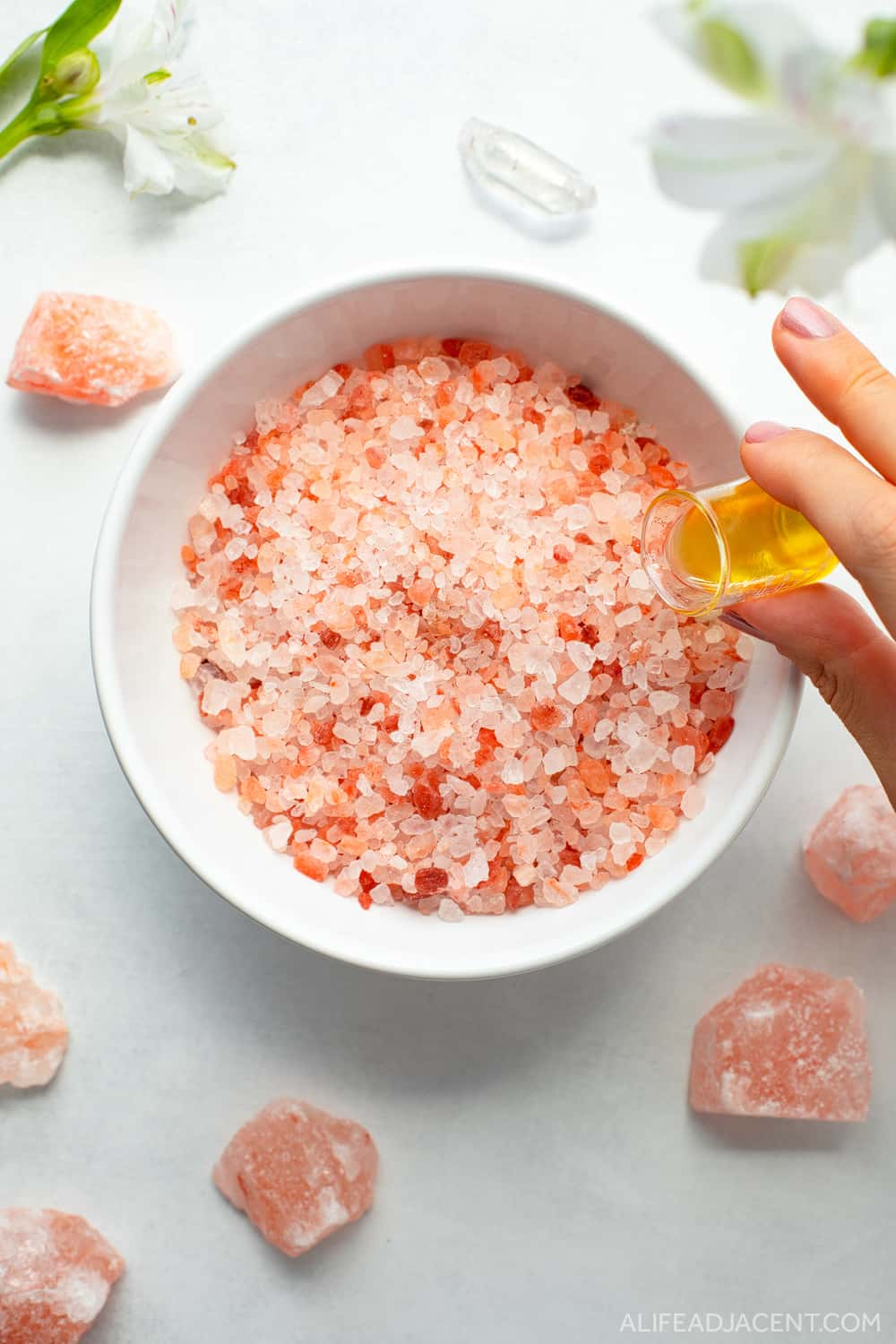
- Continue to mix thoroughly to ensure the pink salts are evenly coated with the essential oils.

- After this step, you can add bath soak extras, such as milk powder or dried herbs or flowers, and then mix again. Alternatively, you can also place dried botanicals on top of the mixture rather than mixing them throughout. If you prefer this method, do this once your salts are packaged.
- Transfer the finished DIY Himalayan bath salts to your preferred storage container with an airtight lid. See suggestions in the section on packaging salt baths below.
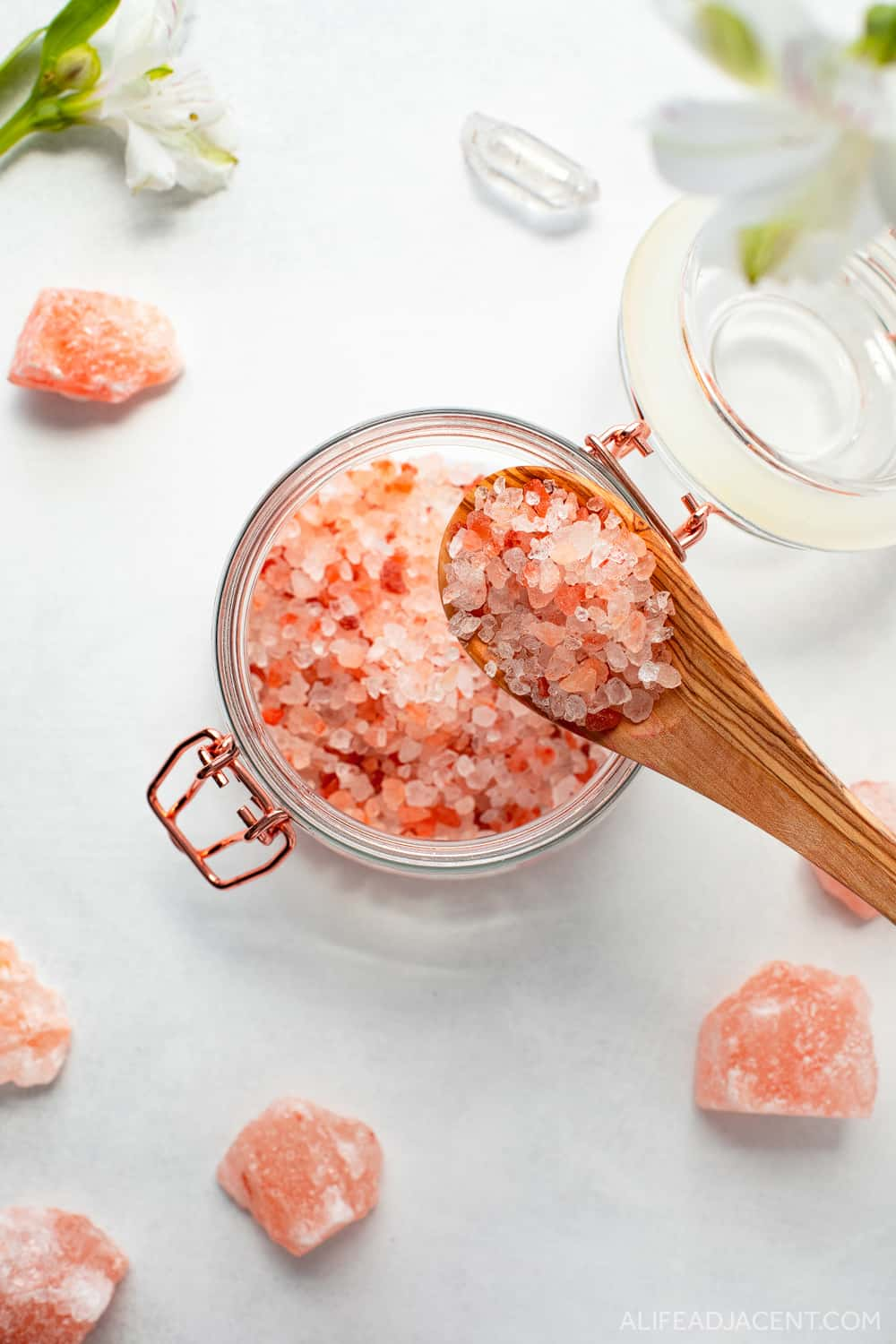
How to take a pink Himalayan salt bath
Some people rinse off in the shower before a salt bath, but this is personal preference. If you want to prerinse before bathing, do this first.

To prepare a pink salt bath, fill your bathtub with warm water. Water that’s too hot can be dangerous, so be sure not to use overly hot or scalding water when bathing in salt.
Add 1-2 cups of Himalayan bath salts to your tub. To dissolve the salts more quickly, you can use your hand to swirl them around your tub. If the salt you used has coarser granules, or if you’re using pink salt rocks, be sure to double check that the salt has completely dissolved before stepping into the tub to avoid injury.
Carefully step into the tub, then relax and allow this luxurious pink salt bath to soothe both your mind and body. Bathe in pink salt for approximately 20 minutes to allow your skin to absorb its benefits.
To prevent itching, you can rinse any salt residue off your skin with a quick cool rinse. Use caution when exiting the bath, as bath salts can make surfaces more slippery.
Lightly pat your skin with a clean towel, then while your skin is still damp, apply a moisturizing body lotion or body butter (such as our sugar cookie body butter or lemon body butter for glowing skin).
To prevent dehydration, it’s a good idea to rehydrate after a hot bath with a cool drink.

Himalayan salt foot bath
A Himalayan pink salt bath can help relieve tired, achy feet as well as combat foot odor. So, If you’re not a bath person, you can use this salt bath recipe as a foot soak instead.
To make a DIY Himalayan salt foot soak, dissolve 1/2 cup pink salts in a basin of warm water. The basin should be filled enough to entirely submerge your feet.
Relax for approximately 15-20 minutes. Have a towel nearby to pat your feet dry, and apply a lotion or body butter after to lock moisture into your feet.
You can use any of the essential oil blends below for a pink salt foot bath, but essential oils that are especially useful for foot care include peppermint, eucalyptus, tea tree, and patchouli.
How to package Himalayan bath salts
There are a number of ways to package a homemade salt bath. You can use a clamp lid mason jar (such as the rose gold clamp jar pictured in the photos) or a classic bath salt jar with an attached wooden spoon.
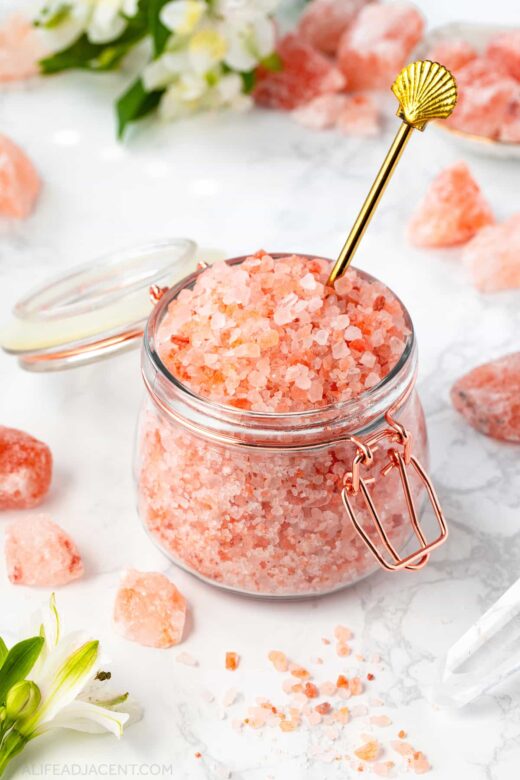
More homemade bath salts packaging ideas:
- Glass bath salt test tubes (see our Green Tea Bath)
- Repurposed milk bottles (see our Milk and Honey Bath Soak Recipe)
- Cotton muslin bath tea bags (see our Chocolate Rose Bath Salts)
- Classic mason jar (see our Pink Lemonade Tub Tea)
For gifting your pink salt bath, you can add a gift tag attached with ribbon or raffia string to your jar. You can see an example of simple handmade gift tags in our Rose Bath Bombs.
For even more ideas on how to packaging your pink salt soak, see our post on the best containers for DIY bath and body products.
🌿 Himalayan Salt Bath Essential Oil Blends
Below are 6 essential oil blends to compliment Himalayan bath salts.
You can also create your own essential oil blends for your salt soak. However, it’s important to be sure to use only essential oils that are safe for the bath, and do not exceed their maximum recommended usage level. The book Essential Oil Safety is a great resource.
For optimal skin safety, the Tisserand Institute recommends adding no more than 5-20 drops of essential oil per bath.
Rest and Relaxation
20 drops lavender essential oil
20 drops vanilla oleoresin
A Himayalan salt bath with lavender oil promotes more restful sleep and relaxes the mind and body.
Lavender essential oil is known to aid relaxation and help alleviate insomnia, which is why it’s often touted as a natural sleep remedy, and the aroma of vanilla is also known to help calm anxiety.
However, vanilla oil is expensive and not always easy to find, so you can substitute ylang ylang essential oil for its sweet fragrance and similar calming effects.
Pain Relief
15 drops ginger essential oil
10 drops star anise essential oil
5 drops cedarwood essential oil
Help soothe and restore tired, achy muscles, menstrual cramps with this warming salt bath recipe.
Ginger and star anise essential oils stimulate circulation, help ease pain, and may also help relieve digestive discomfort and bloating. As a bonus, ginger also helps you sweat, which is said to aid detox.
Tropical Escape
14 drops ylang ylang essential oil
14 drops ho wood essential oil
12 drops blood orange essential oil
Escape to the tropics for some relaxation with this tropical, sweet smelling blend. This salt bath recipe helps boost mood and calm the mind and body while reminding you of relaxing days at the beach.
With the salty water and tropical scent inspired by our Tropical Escape essential oil perfume, this salt bath is almost like bringing the beach home.
Energy Cleansing
20 drops sage essential oil
15 drops ho wood essential oil
4 drops bay leaf essential oil
Sage, ho wood and bay leaf are said to have spiritual cleansing properties, making them a perfect addition to a spiritual bath ritual. You can add these sacred essential oils to your pink salt bath soak to cleanse your energy. You can also opt to use an aura cleansing spray to clear the room before soaking.
Fitness
40 drops Fit essential oil blend
Alternatively, you can use:
16 drops grapefruit essential oil
14 drops spearmint essential oil
10 drops lavender essential oil
Adding this refreshing and invigorating essential oil blend to your salt bath can help support your fitness routine.
The aroma of spearmint and grapefruit essential oils can help reduce cravings and emotional snacking. They can also boost energy, leading to better workouts, which can also help you achieve your fitness goals.
Congestion and Sinus
20 drops peppermint essential oil
20 drops eucalyptus essential oil
If you’re congested or feeling under the weather, taking a pink salt bath with peppermint and eucalyptus oils may help provide some relief from congestion or sinus discomfort.
Peppermint and eucalyptus are some of the best decongestant essential oils. Plus, these oils can also help soothe and revitalize tired, achy muscles, heavy legs, or achy feet.
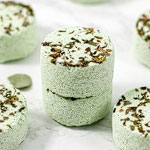
Skin Relief
40 drops blue tansy essential oil
Blue tansy oil is high in chamazulene, a potent antioxidant with calming, pain-relieving, and anti-allergy effects. It also has anti-inflammatory and antihistamine properties, so taking a salt bath with blue tansy oil may help relieve skin irritation.

Himalayan Salt Bath Recipe
Relax and rejuvenate your mind, body and soul with a Himalayan salt bath. With these easy to make pink salt bath soak recipes, you can enjoy a relaxing spa treatment right in the comfort of your own bathroom.
Materials
- 4 cups pink Himalayan salt crystals
- 1 tsp / 5ml caprylyl/capryl glucoside solubilizer
- 40 drops essential oils (see blends above)
Optional Ingredients
Tools
- Supplies needed to make pink bath salts
- Large glass mixing bowl
- Wooden spoon for mixing
- Small glass beaker for emulsifier and essential oils
- Small spatula to mix oil blend
- Storage jars
Instructions
- To make a Himalayan salt bath, start by placing the pink salts into a large glass mixing bowl.
- Measure the natural emulsifier into a separate small container or glass beaker. Then, add your favorite essential oils – see the bath salt essential oil blends section above.
- Mix well with a small spoon or spatula to fully solubilize the essential oils in the emulsifier. Then, slowly drizzle this mixture over the bath salts, using a wooden spoon to mix as you go.
- Continue to mix thoroughly to ensure the pink salts are evenly coated with the essential oils.
- After this step, you can add bath soak extras, such as milk powder or dried herbs or flowers, and then mix again. Alternatively, you can also place dried botanicals on top of the mixture rather than mixing them throughout. If you prefer this method, do this once your salts are packaged.
- Transfer the finished DIY Himalayan bath salts to your preferred storage container with an airtight lid. See suggestions in the section on packaging salt baths.
Recommended Products
As an Amazon Associate and member of other affiliate programs, we earn from qualifying purchases.
❓ Frequently Asked Questions
How much pink Himalayan salt should you use in bath water?
You can use anywhere from 1/2 cup to 2 cups of pink salt per bath.
As a general rule, 1 cup of pink salt per bath is a good starting point, but you can use less if you find that salt baths make your skin itchy. If this occurs, start with 1/2 cup of pink salt in your bath water and adjust as necessary.
Do not exceed 2 cups per bath. Not because the salt is harmful (the ocean’s salt water is far saltier) but simply because too much essential oils in your bath water may cause skin irritation.
How often should you take a salt bath?
Taking a Himalayan salt bath 2-3 times a week is a good starting point. However, be sure to watch for signs of dry skin or irritation.
Barring any health or skin conditions, there’s no evidence that bathing in salt water every day is harmful. But as mentioned, it’s important to consult your health practitioner to see what’s right for you.
Can you get pink salt water in your hair?
Salt water is a natural hair texturizer, so you can dip your hair in your salt bath if you want to recreate the tousled, wavy hair look you get after a dip in the ocean.
However, some people may find salt water dries out their hair, so you may want to tie up your hair while taking a salt bath.
How long do Himalayan bath salts last?
Like all salt, Himalayan pink salt lasts indefinitely as long as its kept under cool, dry conditions. However, this Himayalan salt bath contains added ingredients like essential oils and optional milk powder, so its shelf-life will depend on these ingredients. Check the labels of those ingredients for expiration dates.
But as a general rule of thumb, use this pink salt bath recipe within 1 year.
How to store Himalayan bath soak
Store Himalayan bath salts in a cool, dark place, away from light, heat, or high humidity.
Salts are highly sensitive to moisture, and this pink salt soak is no exception. If left exposed to air, the natural emulsifier in this recipe will pull even more water into the salts, causing them to stick together.
If the pink salts do become hard or clumpy, they’re still fine to use, but getting them out of your storage container might be more difficult. Be sure to store your salt bath in a container with an airtight seal, and seal the container tightly between uses.
Himalayan salt bath side effects
Experts seem to agree that bathing is generally safe11. However, every person is unique, so it’s always best to consult with your health care provider to discuss any potential side effects.
Potential side effects of bathing in Himalayan pink salt may include dry, itchy skin, skin rashes, or even a burning or stinging sensation, especially if you bathe with freshly shaved skin. Avoid salt baths after shaving, if you have any cuts or damaged skin, or if you have very sensitive skin.
These Himalayan bath salt recipes are likely safe for most people. However, it’s possible that some people may be allergic to one or more ingredients. If you experience any redness or skin irritation, discontinue use and do not take another salt bath.
It’s also a good idea to do a patch test when using new ingredients or when introducing any new essential oil into your wellness routine, especially if you have sensitive or or allergy-prone skin.
Additionally, if you suffer from any health conditions, such as high or low blood pressure, diabetes, heart conditions, or are pregnant or breastfeeding, please consult with your health care provider before taking a salt bath and before using a homemade bath soak.
More salt bath recipes and bath soaks
For even more relaxing and rejuvenating bath recipes using Himalayan pink salt, be sure to check out the following DIY bath soaks:
- Green Tea Bath
- Milk and Honey Bath Soak
- Pumpkin Spice Bath Salts
- Pink Lemonade Tub Tea
- DIY Bath Salts for Gifts
- Chocolate Rose Tub Tea
For even more DIY bath and body recipes, follow us on Pinterest, Instagram, YouTube, Facebook, TikTok, and Twitter.
Pin it for later

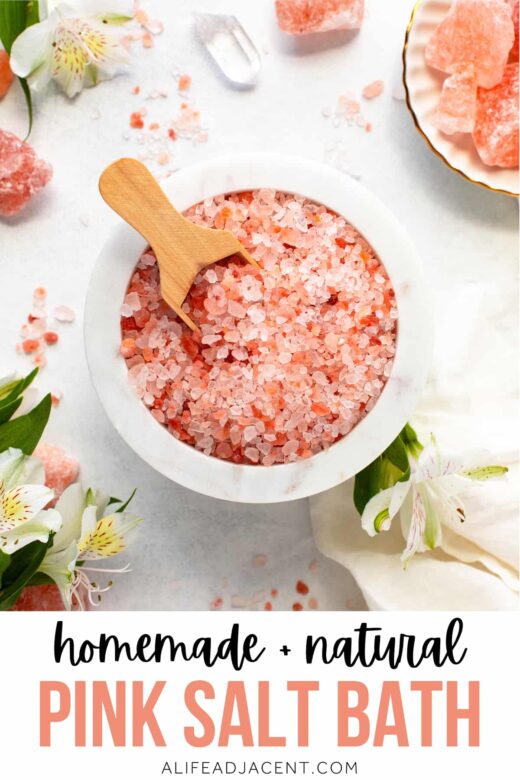
- Narishkin, Abby. “How 800 Million Pounds of Himalayan Salt Are Mined Each Year.” Business Insider, www.businessinsider.com/how-800-million-pounds-of-himalayan-salt-are-mined-yearly-2021-2?r=US&IR=T. Accessed 6 July 2023.
- Gröber, Uwe et al. “Myth or Reality-Transdermal Magnesium?.” Nutrients vol. 9,8 813. 28 Jul. 2017, doi:10.3390/nu9080813
- Kamioka, Hiroharu et al. “Overview of Systematic Reviews with Meta-Analysis Based on Randomized Controlled Trials of Balneotherapy and Spa Therapy from 2000 to 2019.” International journal of general medicine vol. 13 429-442. 22 Jul. 2020, doi:10.2147/IJGM.S261820
- Preston, Kahla. “Myth or Fact: Is Salt Water Good for Your Skin?” Mamamia, 22 Feb. 2016, www.mamamia.com.au/is-salt-water-good-for-your-skin/.
- Sima Halevy a, et al. “Dead Sea Bath Salt for the Treatment of Psoriasis Vulgaris: A Double-Blind Controlled Study.” Journal of the European Academy of Dermatology and Venereology, 19 Feb. 1998, www.sciencedirect.com/science/article/abs/pii/S0926995997001335.
- Samidah, Sitti et al. “The effectiveness of 7% table salt concentration test to increase collagen in the healing process of wound.” Gaceta sanitaria vol. 35 Suppl 2 (2021): S199-S201. doi:10.1016/j.gaceta.2021.07.015
- Proksch, Ehrhardt et al. “Bathing in a magnesium-rich Dead Sea salt solution improves skin barrier function, enhances skin hydration, and reduces inflammation in atopic dry skin.” International journal of dermatologyvol. 44,2 (2005): 151-7. doi:10.1111/j.1365-4632.2005.02079.x
- Goto, Yasuaki et al. “Physical and Mental Effects of Bathing: A Randomized Intervention Study.” Evidence-based complementary and alternative medicine : eCAM vol. 2018 9521086. 7 Jun. 2018, doi:10.1155/2018/9521086
- Sujan, M U et al. “Influence of hydrotherapy on clinical and cardiac autonomic function in migraine patients.” Journal of neurosciences in rural practicevol. 7,1 (2016): 109-13. doi:10.4103/0976-3147.165389
- Wasik, Anita A, and Tamara Tuuminen. “Salt Therapy as a Complementary Method for the Treatment of Respiratory Tract Diseases, With a Focus on Mold-Related Illness.” Alternative therapies in health and medicine vol. 27,S1 (2021): 223-239.
- “Hot Baths and Saunas: Beneficial for Your Heart?” Harvard Health, 1 Oct. 2020, www.health.harvard.edu/heart-health/hot-baths-and-saunas-beneficial-for-your-heart.

